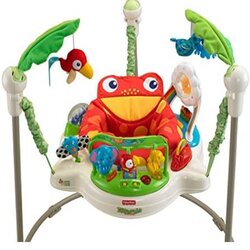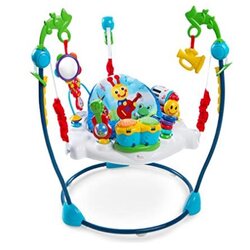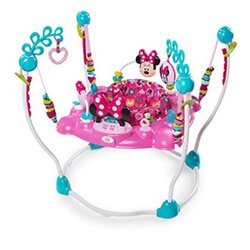Being the parents of an infant, you must be gushing over the fact “has your baby is aged enough to be on a jumper?” Or is there any age limit for a baby to use a jumper?
Well, yes, there is.
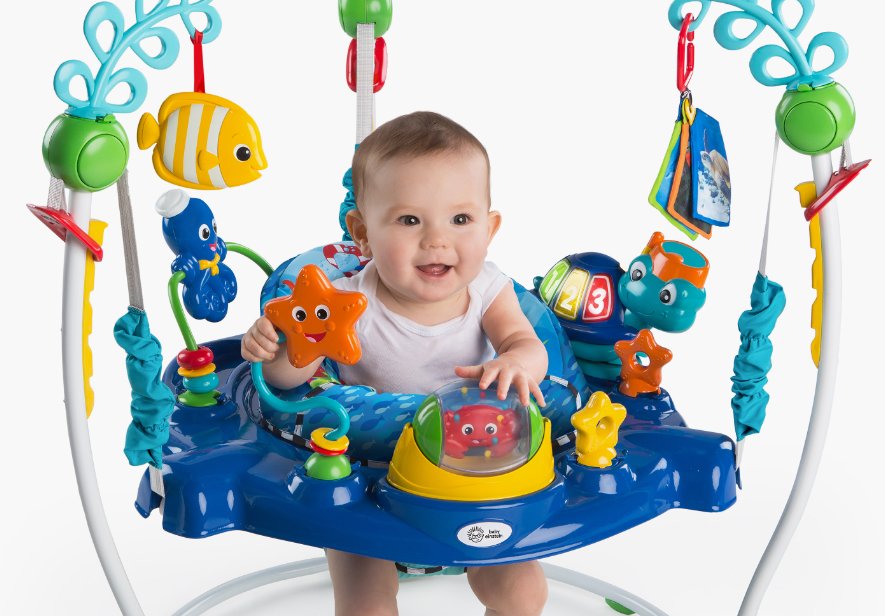
A baby jumper has multiple facets of benefits to your child, and it maximizes if used within a specific time frame. Though none of the theories has established any particular baby age limit to use a jumper safely, in general from 4 to 12 months is calculated to be the favorable time frame.
Proper exposure to the fact “baby jumper age limit” can make the baby jumper the toast of your parenthood.
Follow the write-up till the end to figure out more elements regarding a jumper for babies.
Do Babies need a jumper?
Truth be told, a jumper probably is not mandatory, but it is beneficial for your child’s overall growth. It profits both the physical and psychological development of a baby. It even plays a dynamic role in enhancing the walking skills of a kid.
Healthy jumping and bouncing also help babies to gain leg muscle development. It appears as a form of healthy exercise to the child and enhances sleep patterns. Apart from the physical benefits, jumping can appease your ears with your baby’s loud giggle and laughter as a jumper baby mostly enjoys this activity.
The bottom line is babies need a jumper for balanced mental and physical progress, and investing in the best baby jumper will sure pay you off.
Benefits of Baby Jumpers
Baby jumpers offer numerous benefits for both babies and parents:
- Physical Development: Using a baby jumper can help strengthen a baby’s leg muscles, preparing them for crawling and walking.
- Entertainment: Jumpers come with toys, lights, and music that can keep babies engaged and happy.
- Hands-Free Time: Parents can get a brief reprieve to attend to other tasks while their baby enjoys some independent playtime.
- Improved Sleep: The physical activity from jumping can help tire out babies, potentially leading to better sleep patterns.
When Can Babies Use Jumpers?
The ideal age for introducing a baby to a jumper is a crucial factor in ensuring their safety and enjoyment. While there’s no one-size-fits-all answer, we can establish some guidelines.
1. Head and Neck Control
The first milestone to consider is your baby’s ability to hold their head and neck upright without assistance. This skill typically develops around 3 to 4 months, although some babies may take a bit longer. Ensure that your baby can support their head confidently for several minutes before using a jumper.
2. Torso Support
In addition to head control, your baby should also demonstrate the ability to support their torso. This means they can sit with minimal assistance and maintain their upper body’s stability. This milestone often coincides with head control and typically occurs around 3 to 6 months.
3. Weight and Height Limits
Most baby jumpers have manufacturer specifications regarding weight and height limits. These limits are essential to ensure your baby’s safety. As a general guideline, babies should weigh 25 pounds or less and be no taller than 30 inches to use a typical jumper safely.
4. Age Range
Considering the milestones mentioned above, many experts and parents recommend introducing a baby to a jumper between 4 and 6 months of age. This period allows your baby to develop the necessary head and torso control and typically coincides with the manufacturer’s recommendations.
Check out my Favorite 3 Baby Jumper picks with high weight limits
Fisher-Price Rainforest Jumperoo
- 3 adjustable height position
- Maximum weight limit: 12kg
- Certified frustration-free
Baby Einstein Neighborhood
- Lights and Melodies
- Maximum weight limit: 11kg
- 4 height adjustments
Disney Baby MINNIE MOUSE
- 12 toys and activities with extra toy loops
- Maximum weight limit: 11kg
- Long Battery life: 96 hours
When do babies stop using jumpers?
When to Stop Using Baby Jumpers
While you’ve determined when to start using a baby jumper, it’s equally important to know when to stop. Here are some factors to consider:
- Crawling and Climbing: Once your baby starts crawling or attempting to climb out of the jumper, it’s time to discontinue its use. Jumpers are not safe for mobile babies.
- Walking: When your baby begins taking their first steps and learning to walk, they no longer need the support of a jumper.
- Manufacturer Guidelines: Always adhere to the manufacturer’s guidelines regarding weight and height limits. If your baby exceeds these limits, it’s time to stop using the jumper.
- Safety Warning: Experts recommend not allowing your baby to spend more than 15 to 20 minutes in a jumper at a time. Be cautious and gradually increase the time if necessary, but never exceed safe limits.
Can a 3-Month-Old Use a Jumper?
Some parents wonder if it’s safe for a 3-month-old baby to use a jumper. In general, it is safe if the baby meets the developmental milestones we discussed earlier. However, it’s essential to assess your baby’s readiness individually, as development varies from child to child.
Safety Considerations
Safety should always be a top priority when using baby jumpers:
- Regularly Inspect the Jumper: Check for any loose parts, damaged straps, or worn-out components. Ensure that the jumper is in good condition.
- Supervision: Never leave your baby unattended in a jumper, and always keep an eye on them while they play.
- Assembly: Follow the manufacturer’s assembly instructions carefully to ensure the jumper is properly set up.
- Time Limit: As mentioned earlier, limit your baby’s time in the jumper to no more than 15 to 20 minutes per session.
- Height Adjustments: Ensure that the jumper’s height is suitable for your baby’s size to prevent discomfort or injury.
Can 3-month-old use a jumper?
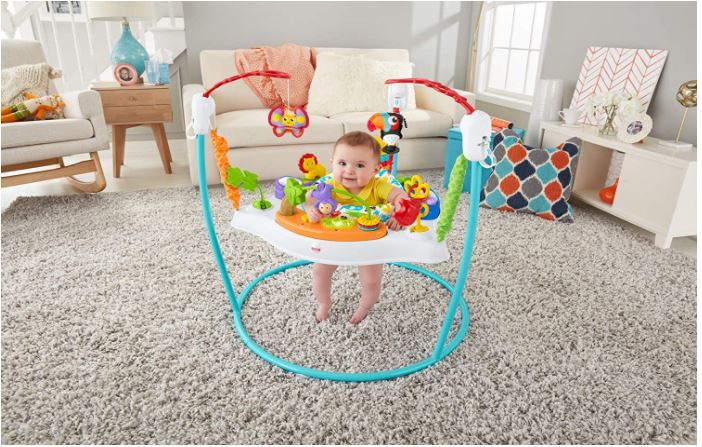
To be utterly precise, yes, a 3-month-old baby who can hold the head and neck without any support can use a baby jumper. Even records claim that a 2-month-old baby may use a baby jumper; it merely depends on whether the infant is ready physically or not.
Can you bounce a baby too hard in a bouncer?
NO, absolutely not. It can be fatal for your little angel. Often, babysitters due to lack of experience and even parents bounce baby too hard on a jumper.
It may result in shaken baby syndrome, behavior disorders, seizures, permanent disabilities, hearing and speech disorders, cerebral palsy, sight issues even blindness, severe brain damage, and other health concerns.
If not so severe, hard bouncing can result in prolonged vomiting, lessened speech or response, breathing problems, loss of appetite and breathing issues.
The Ultimate Buying Guide: Things to consider before buying a Baby Jumper
An efficient buying guide can prevent repetitive buying; thus, check the buying guide below to identify the best among the ordinaries.
Material
Regarding the frame, high-quality plastics are good, but metal frames are the safest. Always avoid low quality plastic frames as it can lead to breakage due to continuous usage. The material must be strong enough to hold a baby’s weight.
The seats should be padded to add extra comfort. Washable, preferably machine washable material, works great to limit the manual hassles.
Seat Size
Different brands manufacture different seat dimensions. If you have a chubby child, consider the seat size to be wider. And for regular or thin kids the, standard seat size would do well. Apt seat size is mandatory as loose or tight seats would be discomforting.
Seat flexibility
During the usage time of a baby jumper, babies can grow by a couple of inches. A baby jumper with a higher adjustable range is convenient to adjust the seat altitude. No matter how much your child grows, you can always change the seat altitude as per the requirement.
Toys
Every jumper comes with a baby toy bar to entertain the infants. An excessively loaded toy bar may annoy your child, and he/ she may not want to play. Even fewer or no toys on the bar can make a kid bored. An adequate amount of baby toys work great. Toys with educational purposes as buttons, levers, bright shapes, and colors can benefit children in the future.
Sound and Music
A high-end baby jumper can also add music and sound systems. Choose one with soothing nature sounds, lullaby, or soft music. If your child has rhythmic movement disorder, sound containing beats can help them calm themselves.
Safety
Research the customer reviews to find out such models with no prior accident records. Robust construction with a metal frame is reliable. Make sure you don’t buy anything that contains harmful substances. A seat altitude that goes up to the armpit length of the baby is safe for jumping. Consider the overall measurements.
Baby Jumper Height and Weight Limit
Every jumper comes with manufacturer specifications regarding the minimum and maximum height and weight limit measurement. Before buying any particular baby product, match the specifications to your baby’s body measurements. It is essential to ensure whether the jumper can support your baby well or not.
Mobility and Storage
The baby jumper must be portable and easy to carry so that it can fit in the diaper bag. Foldable seats, easy assembling and disassembling of featured products are good for taking around.
The baby jumper must be compact in size to store them effortlessly and should not take up a lot of space.
Price
A baby jumper is quite essential, but you should never carry the price too far. Baby Jumper usually costs $20 to $200, choose anything that suits within this budget range.
Know the Deal: Advantages and disadvantages of Baby jumper
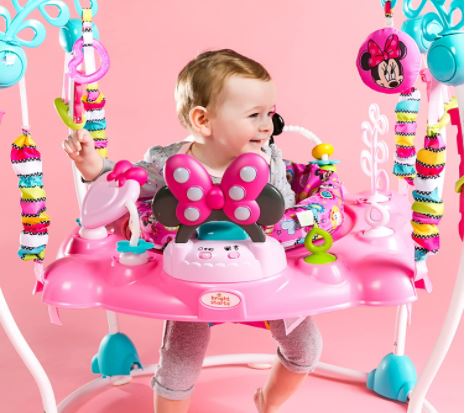
Even once an angel turned into the devil, so can be the baby jumper. A baby Jumper or bouncer is supposed to support the overall development of your baby. But at times, it can be both efficient and harmful to your little one. Let’s analyze the facts:
Advantages of Baby Jumpers
- Improves overall Motor skills which means the movement and coordination among the large body parts such as your baby’s arms, legs.
- Healthy jumping and bouncing improve and strengthens leg muscles. It also plays an active role in muscle development.
- Develops pre-walking skills as jumping involves the functionality of lower body parts. It helps the baby understand to use the bottom limbs (feet, legs) of the body.
- Helps to build a routined sleep pattern. As jumping is a healthy physical activity for infants, it also tires the baby and ensures sound sleep.
- The attached toys and music can be super educative as well. Calming sounds soothe their nerve. Babies can be trained to determine shapes, sizes, patterns, and colors through the toys.
- It is a good entertainment source for the infants, and they thoroughly enjoy the time on a baby jumper.
- Helps to enhance the body balance among the little stars. Advances in eye and body synchronization; thus, Babies start learning to stand on their feet properly and balance the bottom part of the body.
- A jumper baby remains busy for some time, and parents can enjoy some free time as well.
Disadvantages of Baby Jumpers
- Baby Jumper may delay the walking process in infants.
- If babies outgrow the guided height limit and still use the baby jumper, eventually it may result in improper body posture and overall physical imbalance.
- There are chances of certain accidents due to broken harness, lowly built material, baby’s tendency to climb or crawl out.
Conclusion
A baby jumper is highly recommended until the baby jumper age limit is correctly followed. And to summarize the overall discussion, the proper age limit starts from 3 to 6 months and ends within 12 months of age. Let us know in the comment section would you like to gift your infant the baby jumper and when?
Also read:
